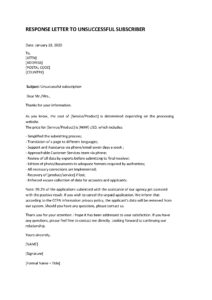Utilizing such a structured document offers several advantages. For individuals, it simplifies the process of exercising their right to be forgotten, ensuring all necessary information is included in the request. For organizations, these documents streamline the handling of erasure requests, reducing the risk of non-compliance and associated penalties. This ultimately fosters greater transparency and trust between organizations and individuals regarding data privacy practices.
Further exploration of this topic will delve into the specific elements typically included in these documents, the legal frameworks governing their use, and best practices for implementation within organizations. Additionally, the discussion will cover the interplay between these requests and other data subject rights, such as access and rectification.
Key Components of a Data Erasure Request
Effective data erasure requests require specific information to ensure clarity and facilitate efficient processing. The following components are typically considered essential:
1: Requestor Identification: Clear identification of the individual making the request is paramount. This typically includes full legal name, current address, and any other relevant identifying information, such as account numbers or usernames associated with the data.
2: Data Specification: A detailed description of the specific data to be erased is crucial. This should include the categories of data concerned, the date range (if applicable), and the systems or platforms where the data is believed to be stored. Greater specificity ensures accurate and complete erasure.
3: Justification for Erasure: While not always mandatory, providing a reason for the request can assist the organization in processing it effectively. Referencing applicable legal grounds, such as the “right to be forgotten,” can strengthen the request.
4: Contact Information: Providing a preferred method of contact (e.g., email address, phone number) enables the organization to communicate updates regarding the request and seek clarification if needed.
5: Signature and Date: Including a signature (where applicable) and the date of the request formalizes the process and helps track the timeframe for response.
6: Authorization: If the request is submitted on behalf of another individual, documentation proving authorization to act as their representative is required. This ensures that requests are made only by authorized parties.
Accurate requestor identification, specific data identification, and clear communication channels are vital for facilitating smooth processing. Providing justification and authorization, where relevant, further strengthens the request and ensures compliance with legal requirements and organizational policies.
How to Create a Data Erasure Request Template
Creating a standardized template ensures data erasure requests are handled efficiently and comply with relevant regulations. A well-designed template benefits both individuals seeking to exercise their data rights and organizations processing such requests.
1: Template Header: Begin with a clear title, such as “Data Erasure Request Form.” Include the organization’s name and contact information. This provides context and a point of contact for inquiries.
2: Requestor Information Section: Dedicate a section for the requestor’s details. Fields should include full legal name, current address, email address, phone number, and any relevant account identifiers (e.g., customer ID, username).
3: Data Specification Section: Provide a structured area for specifying the data subject to erasure. Include fields for data categories, relevant date ranges, and specific systems or platforms where the data resides.
4: Justification and Legal Basis: Include a section for the requestor to state the reason for the erasure request. Providing a space to cite specific legal grounds, such as GDPR articles, can clarify the request’s basis.
5: Authorization (If Applicable): If the request can be submitted by a third party on behalf of the data subject, include a section for authorization details. This section should include fields for the representative’s information and proof of authorization.
6: Signature and Date: Include space for a physical or digital signature and the date of the request. This formalizes the request and helps track its progress.
7: Instructions and Supporting Information: Provide clear instructions on how to submit the completed form and any supporting documentation required. Information on expected processing times and contact details for follow-up can also be included.
8: Data Retention Policy Reference: Include a brief statement or link referencing the organization’s data retention policy. This promotes transparency and informs the requestor about relevant data handling practices.
A comprehensive template facilitates clear communication, streamlines processing, and reinforces compliance with data privacy regulations. Standardized fields for requestor identification, specific data identification, legal justification, authorization, and contact information ensure requests are unambiguous and actionable. Clear instructions and references to organizational policies enhance transparency and efficiency.
Careful consideration of these documented procedures underscores the importance of data privacy in the digital age. Standardized forms provide a clear and accessible mechanism for individuals to exercise their right to data erasure, while enabling organizations to process these requests efficiently and compliantly. Understanding the components of a robust form, coupled with practical guidance on template creation, empowers both individuals and organizations to navigate data privacy requirements effectively.
Implementing robust procedures for handling erasure requests is not merely a legal obligation but a fundamental aspect of fostering trust and transparency. As data privacy regulations continue to evolve, organizations must prioritize the development and implementation of clear, accessible, and efficient procedures. Proactive engagement with these evolving standards ensures compliance and strengthens the relationship between organizations and the individuals whose data they hold.

